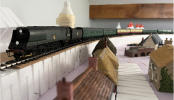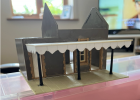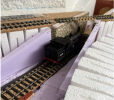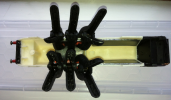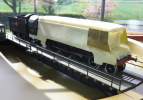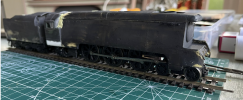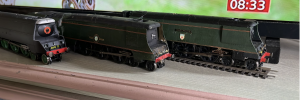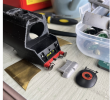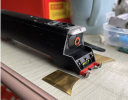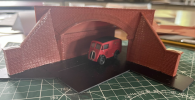A month on and the primary activity has been on locomotives. That's due to a combination of mojo failure and my work obligations that only allows for short periods which are OK for achieving completion of small jobs that add up to a 'done job'. Firstly I continued with my forward dating of 21C7 from the Hornby wartime black livery version. The rear rave of the tender was cut down guided by a picture of the prototype in Hervey's book. This is relatively simple s the rave appears to be cut down to the top of the tender tank.
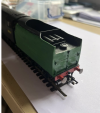
The next task has been to prepare for the fitment of the Albert Goodall / RT brass smoke deflectors. The location to make cuts around the smokebox front is helpfully marked by Hornby's rivet pattern on the casing - very logical:
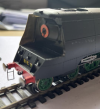
This picture is to illustrate that the fairing is cut down almost to the top of the horizontal sheet afore the firebox door. Again the rivet pattern on the casing corresponds well with the size of the Albert Goodall/RT deflector and the drawings in the Hervey book. The stand-offs provided with the deflector are too long and need cutting back a tad at the rear, preserving the bracket which anchors the deflector to the smoke box front.
Ready now for the second deflector and all the front end detail. The buffer mounted steps are always vulnerable to damage when working on the body as is the case here.
The second project was/is something I wanted to do for some time which was to modify a rebuilt Hornby Merchant Navy principally to see what the effect of changing the Hornby smokebox door out for one by Albert Goodall/RT. I felt the Hornby model did not capture the appearance adequately.
Many moons ago I began a Crownline Merchant Navy kit, determined that this would be my 'tour de force', soldering brass and fettling valve gear. Compensated chassis assembled, tender built, body built, but then all work halted for domestic and work reasons. Then the Hornby MN appeared. So the first mission to produce a 'pride of the line' top link loco stalled.
I looked recently at restarting the exercise but in the intervening years the compensated chassis had locked up meaning disassembly was needed to fix it, and consideration of a Hornby chassis as a quick fix also foundered on the amount of butchery needed on the Crownline body. So that went back in the box for a time when I can prioritise it. However, the Series I tender was prepared for the new project using a Hornby MN starting point. One day, perhaps it will go behind the loco it was built for! However, tender swapping is prototypical.
The work done on the Hornby MN comprised:
1) Remove deflectors and cut off the Hornby smokebox door. Replaced with a cast alternative from Albert Goodall/RT,
2) Fit smokebox door furniture and replace deflectors
3) Fit cylinder drain pipes (also Albert Goodall/ RT),
4) Remove the bogie, reverse it and cut off the coupling housing. This is to improve the front end and to aid fitting of guard irons on the bogie.
5) Fit scale bogie wheels to improve appearance of the front end,
6) Fit brake pull rods by drilling out the shoe and actuating mechanism holes and fitting Peco track pins through them from inside of the chassis to the outside. Drill out the pull rods at the joints with the actuating mechanism and slide over the track pins. Trim and spot glue. They won't now fall off quite so easily!
7) Fit the buffer beam hoses and other details. Glue the route indicator discs in place.
8) Fit the smokebox number and nameplates.
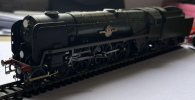
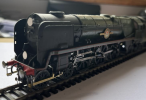
My opinion is that the front end is much improved compared to the original Hornby product. The form of the original smokebox door is too flat in my eyes. Still detail work to do and then to touch up the paint. I am not enamoured with the smoke deflectors and I can see a change out for brass alternatives in the future. However, for now this will be a good outcome for an early 1960's prime hauler on the layout. Sorry the pictures are not crisp - I don't have the knack with the iPhone camera but I hope the model gives the impression of the change in appearance at the front end, subtle it may be. Certainly, if Hornby announce a re-work of the type, I will not feel driven to acquire one.
Similarly the Crownline loco remains in the 'to do' stack and I still aspire to completing it in the future.


